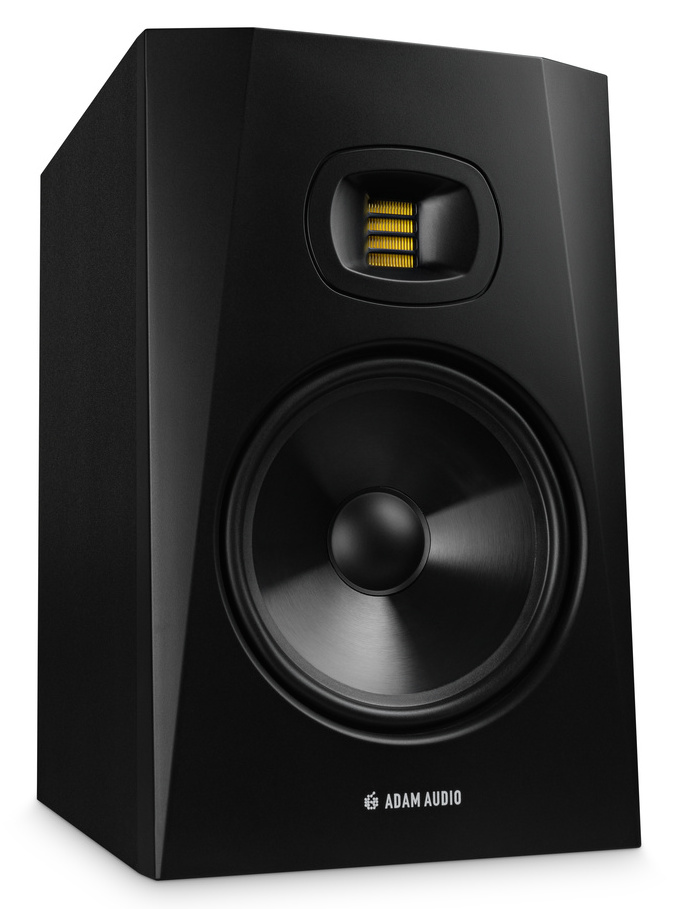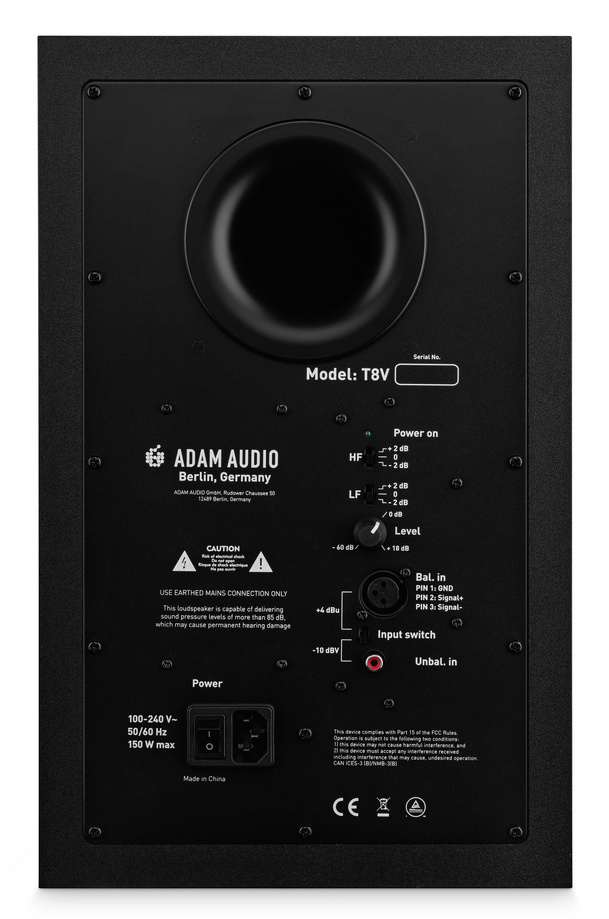New Gear Review: T8V Monitors by ADAM Audio

ADAM Audio welcomes the T8V to their acclaimed T Series. Can this monitor find a home in your studio?
If you’re new to music production, trying to determine what pair of studio monitors suit your needs best will likely lead you down a swift and daunting rabbit hole.
It’s difficult to overstate how integral speakers are to every engineer/producer’s setup, so where do you even start? Enter the budget-friendly T Series by ADAM Audio.
Since their formation in the late ‘90s, ADAM Audio has become a venerable force in recording studios both big and small. Nowadays, their product line of speakers range in price—quite impressively—from $199.99 to $19,999.99 each.
In 2018, the Berlin-based company introduced their first in a series of highly affordable two-way nearfield monitors “optimized for small control rooms.” The T5V and T7V ended up winning a few awards, not to mention a spot in countless studios and homes. One year later, the company focused its efforts on a matching subwoofer, releasing the T10S.
Now, ADAM Audio has returned with the newest addition to the T Series—the T8V. Sharing many similarities with the earlier, smaller “sibling” models, the T8V also has a few evident differences. Let’s take an in-depth look at the T8V and see if it could be a worthwhile investment for audio creatives.
Features
As you can probably guess by its name, the T8V houses an 8” polypropylene woofer—the most obvious distinction upon first glance at this new model. The “V” stands for “vertical,” meaning these speakers are designed to be used only in an upright position.
Providing 118 dB max SPL per pair, ADAM Audio has extended the frequency response of these monitors down to 33 Hz compared to its smaller sibling, the T7V, which reaches 39 Hz. All models in the T Series are fitted with a U-ART (accelerated ribbon technology) 1.9” tweeter made of polyamide film, achieving a frequency response up to 25 kHz. Here’s what the company has to say about this particular design:
“The U-ART tweeter uses a pleated ribbon that alternately draws air into its folds and squeezes it out as the folds respectively expand apart and press together in response to inputted audio signal. This design produces four times as much air movement as does a piston-based design (with the same amount of membrane movement), creating higher sound pressure levels (SPLs) with lower distortion.
“The U-ART tweeter is fitted to a precision waveguide with the same dispersion-control attributes as the High Frequency Propagation (HPS) waveguide used in ADAM Audio’s flagship S Series studio monitors. The waveguide’s highly uniform dispersion of high frequencies provides an incredibly wide sweet spot that frees you from being glued to a rigid mix position while working.”
So, in other words, the claim is that the tweeter design reduces the amount of vertical dispersion. This means that comb filtering should be less of an issue, compared to a typical piston dome tweeter.
Moving on to the rear panel, you’ll find a handful of principle features. The on/off power switch is conveniently located right beside the power cable (100-240 V~). To the right, near the bottom, there are XLR and RCA inputs with a switch for designating whether you’re connecting to pro audio (+4 dBu) or consumer (-10 dBV) devices.
Above the inputs, a level knob ranges from -60 dB to +18 dB with a 0 dB marker labeled clearly between both extremes. Continuing upward, high-shelf and low-shelf filter switches are available to allow easy +2 dB and -2 dB adjustments. There is also a tiny power light indicator in the same region.
Last but not least, a circular bass-reflex port is situated on the back. In a video showcasing the new T8V, product manager Stephan Mauer explains, “Many believe that it’s a disadvantage if the bass-reflex port is at the rear instead of the front of the cabinet because a rear port design allegedly does not allow you to put the speakers right up to the wall.
In my opinion, this is by no means a problem in the real world. Since, first of all, active speakers will likely be spaced a couple of centimeters or inches off the back wall anyways due to power and signal cables coming in. This gap is already sufficient for the low-frequency sound to freely radiate from the bass-reflex port. Secondly, low-frequency sound generally distributes in an omnidirectional way, in all directions.”
In Use
Unboxing the T8Vs, I got an unexpected whiff of that “factory smell” many of us have grown to love/hate. I had absolutely no trouble removing the speakers from the packaging, but I was slightly surprised by their general bulkiness, weighing in at 21.6 lbs each—nearly 6 lbs more than its smaller sibling, the T7V. With that said, the monitors came across as solidly-constructed, sturdy, and sleek in appearance. Over the span of a few days, I tried them both on and off my IsoAcoustics monitor stands.
These specialized stands lift and decouple studio monitors from your desk or supporting surface, helping provide even more clarity and definition in the low end and phantom center. I adjusted the stands to an optimal height according to my usual listening position, and felt pretty good about the results.
When they were off the stands, the biggest perceivable difference was felt in the low frequencies, which would occasionally rumble throughout my desk. Of course, that can also be a pleasant experience when working on certain genres, namely hip hop and EDM—however this can also skew your perception of the frequency spectrum upon playback.
Playing a handful of reference tracks to start, I had no conspicuous issues with the stereo image. The width and depth of the stereo field compared very well to that of similar products. While made in China to help offset costs, I was delighted to discover that the T8Vs were not excessively bright like other monitors at low price points.
Although not as clearly defined as high-end monitors, using the T8Vs to record and mix was a breeze. They certainly didn’t prompt any dire problems.
As always, speakers vary from one pair to the next, and it can take time to get accustomed to a new pair. Elements were occasionally less pronounced in the low mids, while the high mids could be quite present and crisp.
Overall, the lows were notably responsive; this was unmistakable, and it was extremely gratifying listening to bass-driven tracks. They reminded me of the pricier A7X but with less punch.
While it’s impossible to speak about longevity after using these speakers for less than a week, they come with a 2-year warranty with an optional extension after registering online. I can say, after hours of use, both listening (for pleasure) and mixing (for work) on the T8Vs, I felt zero ear fatigue by the end of the day.
To Be Critical
My experience with the T8Vs is primarily without qualms. I was surprised to see the power light indicator on the back of the monitors when traditionally so many are placed on the front. Personally, I imagined it would have been more appropriate on the front for quicker visual reference,
The high and low frequency switches on the back are a nice touch, but I found the perceivable differences when utilized fairly subtle. It’s tough to predict how many engineers/producers will make use of those switches, but it’s worth noting that some similarly priced models offer a wider span (as much as +/- 6 dB).
And when it comes to the level knob, it would have been really helpful to have a detent in the rotation at 0 dB. Even better, why not include lines marking the path from -60 dB to +18 dB? Otherwise, it’s nearly impossible to match the monitoring levels between speakers perfectly.
Summing it Up
In all honesty, I wish the T8V was available when I began my career in audio. My first pair of monitors, even though still in my production room for nostalgic purposes, certainly don’t stack up well against these speakers.
You would be hard-pressed to find many speakers with the kind of clarity the T8V delivers at $299.99 per speaker. The T8Vs are priced quite competitively against similar units by Yamaha, KRK, JBL, and Focal. The individual speaker is only $50 more than the company’s T7V.
The introduction of the T Series is a brilliant way for ADAM Audio to help new music makers get situated with a quality speaker design before they’re prepared to move up the ladder—presumably to the company’s AX Series and S Series.
Overall, the new T8V monitors are a wonderful solution for home studios with a modest monitoring budget.
Michael Duncan is a record producer, engineer, and writer who lives in NYC.
Please note: When you buy products through links on this page, we may earn an affiliate commission.








[…] http://sonicscoop.com/2020/06/23/new-gear-review-t8v-monitors-by-adam-audio/ New Gear Review: T8V Monitors by ADAM Audio […]